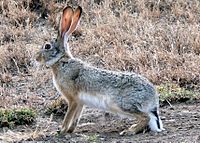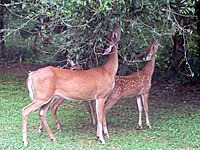
European Brown hare (Lepus europaeus) as a source of emerging and re‐emerging pathogens of Public Health importance: A review
Sign Up to like & getrecommendations! Published in 2020 at "Veterinary Medicine and Science"
DOI: 10.1002/vms3.248
Abstract: Abstract European brown hare (Lepus europaeus, EBH) is probably the most important game animal in Europe throughout its historical distribution. The decline in its populations across its geographic range in Europe have been attributed to… read more here.
Keywords: hare; source; epidemiology; european brown ... See more keywords

Goose and hare faeces as a source of nutrients and dissolved organic matter for bacterial communities in the newly formed proglacial lake Ventisquero Negro (Patagonia, Argentina)
Sign Up to like & getrecommendations! Published in 2020 at "Hydrobiologia"
DOI: 10.1007/s10750-020-04202-4
Abstract: Dissolved organic matter (DOM) input is a key factor for freshwater ecology, since it regulates many aspects of aquatic ecosystem metabolism. Aquatic and terrestrial animals that inhabit or frequent aquatic environments also influence the DOM… read more here.
Keywords: newly formed; hare; organic matter; dissolved organic ... See more keywords

“Hare Tracks” in the Upper Palaeolithic in the centre of the East-European Plain (an overview)
Sign Up to like & getrecommendations! Published in 2020 at "Quaternary International"
DOI: 10.1016/j.quaint.2020.10.017
Abstract: Abstract The paper is devoted to the role of hares in the composition of hunter's prey in the Upper Paleolithic of the Russian (East European) Plain. Mammoths and hoofed mammals are traditionally considered as main… read more here.
Keywords: east european; hare; tracks upper; hare tracks ... See more keywords

The evolutionary history of the Cape hare (Lepus capensis sensu lato): insights for systematics and biogeography
Sign Up to like & getrecommendations! Published in 2019 at "Heredity"
DOI: 10.1038/s41437-019-0229-8
Abstract: Inferring the phylogeography of species with large distributions helps deciphering major diversification patterns that may occur in parallel across taxa. Here, we infer the evolutionary history of the Cape hare, Lepus capensis sensu lato, a… read more here.
Keywords: cape hare; hare; capensis; cape ... See more keywords

Myxoma virus jumps species to the Iberian hare.
Sign Up to like & getrecommendations! Published in 2019 at "Transboundary and emerging diseases"
DOI: 10.1111/tbed.13296
Abstract: The study of myxoma virus (MYXV) infections in the European rabbit (Oryctolagus cuniculus) has produced one of the most accepted host-pathogen evolutionary models. To date myxomatosis has been limited to the European rabbit with sporadic… read more here.
Keywords: iberian hare; hare; european rabbit; myxoma virus ... See more keywords

Spillover event of recombinant Lagovirus europaeus/GI.2 into the Iberian hare (Lepus granatensis) in Spain.
Sign Up to like & getrecommendations! Published in 2021 at "Transboundary and emerging diseases"
DOI: 10.1111/tbed.14264
Abstract: Viruses that affect lagomorphs have decades of reported history of spillover events. One of these viruses are the causative agents of the so-called rabbit or "lagomorph" haemorrhagic disease (e.g., Lagovirus europaeus/GI.1 and L. europaeus/GI.2). In… read more here.
Keywords: hare; spillover event; lagovirus europaeus; iberian hare ... See more keywords

Short-term changes in spatial distribution pattern of an herbivore in response to accumulating snow
Sign Up to like & getrecommendations! Published in 2017 at "Canadian Journal of Zoology"
DOI: 10.1139/cjz-2016-0287
Abstract: Deep snow can reduce accessibility to vegetation and cover by herbivores by blanketing understory cover, yet simultaneously increase access to foliage at higher levels. Thus, snow depth fluctuation should lead to spatiotemporal variation in herbivore… read more here.
Keywords: ground; herbivore; response; hare ... See more keywords

Haplotype associated RNA expression (HARE) improves prediction of complex traits in maize
Sign Up to like & getrecommendations! Published in 2021 at "PLoS Genetics"
DOI: 10.1371/journal.pgen.1009568
Abstract: Genomic prediction typically relies on associations between single-site polymorphisms and traits of interest. This representation of genomic variability has been successful for predicting many complex traits. However, it usually cannot capture the combination of alleles… read more here.
Keywords: hare; rna expression; expression; complex traits ... See more keywords

Large-scale mitochondrial DNA analysis reveals new light on the phylogeography of Central and Eastern-European Brown hare (Lepus europaeus Pallas, 1778)
Sign Up to like & getrecommendations! Published in 2018 at "PLoS ONE"
DOI: 10.1371/journal.pone.0204653
Abstract: European brown hare, Lepus europaeus, from Central and Eastern European countries (Hungary, Poland, Serbia, Lithuania, Romania, Georgia and Italy) were sampled, and phylogenetic analyses were carried out on two datasets: 1.) 137 sequences (358 bp)… read more here.
Keywords: hare; central eastern; eastern european; european brown ... See more keywords

Ancient DNA of the Don-Hares Assumes the Existence of Two Distinct Mitochondrial Clades in Northeast Asia
Sign Up to like & getrecommendations! Published in 2023 at "Genes"
DOI: 10.3390/genes14030700
Abstract: Paleoclimatic changes during the Pleistocene–Holocene transition is suggested as a main factor that led to species extinction, including the woolly mammoth (Mammuthus primigenius), Steller’s sea cow (Hydrodamalis gigas) and the Don-hare (Lepus tanaiticus). These species… read more here.
Keywords: ancient dna; hares assumes; dna hares; distinct mitochondrial ... See more keywords

Phylogenetic Analysis of European Brown Hare Syndrome Virus Strains from Poland (1992–2004)
Sign Up to like & getrecommendations! Published in 2021 at "Viruses"
DOI: 10.3390/v13101999
Abstract: European brown hare syndrome (EBHS) is lethal to several species of free-living hares worldwide. The genetic characterization of its virus (EBHSV) strains in European circulation and epidemiological knowledge of EBHSV infections is not yet complete.… read more here.
Keywords: hare; virus strains; ebhsv strains; strains poland ... See more keywords